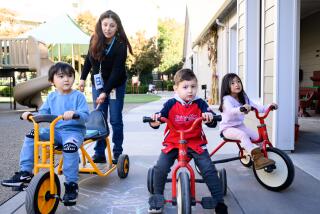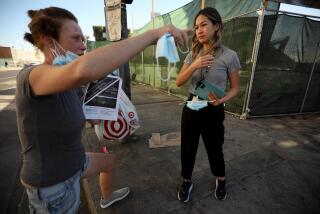Herpes Panic in Classroom--Fear Is Based on Misinformation
- Share via
Absenteeism was about twice normal Wednesday at a Sacramento elementary school where angry parents toted picket signs last week protesting the enrollment of a 4-year-old boy.
Across the country, in suburban Pasadena, Md., a 3-year-old boy who spawned a similar furor there spent an eighth day alone in his classroom, while in Council Bluffs, Iowa, a boycott at Longfellow Elementary School finally eased when a judge ruled that a 3-year-old girl known only as Jane Doe has a right to be educated.
Despite the thousands of miles separating them, the catalyst for the angry words, the picketing and the classroom boycotts in all three cases was the same: Each preschooler has a form of herpes.
Although commonly viewed as a sexual disease, there are, in fact, four strains of the herpes virus that are neither acquired by nor related to sexual contact. Each of the toddlers suffers from one of these non-sexual varieties. Two suffer from sores and the third shows no symptoms at all.
But tainted nonetheless by the notion of children with a sexually transmitted disease and fueled by fears of epidemic and misinformation about the ailment, the hysteria surrounding their enrollments kept emotions high and, health experts say, the truth at arm’s length.
What impact the slowly easing turmoil will have on the trio of children, their classmates and parents is incalculable. In any case, health experts say, the fears and suspicions left in the wake of the past few days will no doubt leave a bigger imprint on those lives than the disease itself.
“It’s a panic situation very much reminiscent of the McCarthy days to me,” said John Graves, director of the Palo Alto-based Herpes Resource Center. “The poor little kid will have to grow up with this now. I have trouble believing he’s not going to be treated differently for a long, long time.”
What began early last week as a news brief about toddler John Bigley’s enrollment in his Maryland preschool class quickly grew into major controversy because “somebody knew just enough to be ignorant,” said Dr. Shirley Fannin, Los Angeles County’s associate deputy director for communicable disease control programs. “They demanded somebody do something and it became a news story.”
The contagion spread when parents “put two and two together and got 1,000,” said Dr. James Chin, chief of the state’s Infectious Disease Control Section. “They don’t know what the real world is.”
In fact, say Chin and others, herpes is much more widespread than commonly believed. “It’s like a common cold type of thing,” he said. “It’s happening all the time.”
An estimated 40% of all children come in contact with the virus by kindergarten age and most develop immunities. For others, the symptoms can be so mild that there is virtually no evidence of the disease. Only a small percentage suffer from the festering lesions associated with herpes. Likewise, 80% to 90% of adults have contracted some form of the herpes virus before reaching middle age and few show lasting effects.
The painful case of shingles that is keeping former President Richard M. Nixon from attending the Reagan inauguration next Monday is the product of one herpes virus, while the fever that hospitalized Pope John Paul II in 1981 was the result of another. “If you start excluding people who have any kind of herpes, there won’t be many people left,” Chin said. “We can’t isolate ourselves from all kinds of human beings because we don’t know who may or may not be shedding (excreting) the disease.”
Once contracted, the virus is carried in the body for years, sometimes never to appear and other times resurfacing only infrequently. There is no known cure.
In all, there are five separate herpes viruses, including the sexually transmitted strain, which intermittently produces painful sores near the genitals. Other strains can take the form of cold sores, chicken pox and infectious mononucleosis. With the common cytomegalovirus (CMV) strain, there are typically no symptoms at all.
“If we go out and check any 100 kids, 33% are likely to be shedding,” Fannin said. “If these people (picketing) the schools took their children and tested them, they could find they had a pariah at home.
“How can I prevent coming in contact with it 100%?” she asked. “The answer is there is no way. Most sources are going to be totally unknown to you.”
While outbreaks of the virus may be uncomfortable, they are rarely dangerous, experts say.
Mainly at risk are newborn infants and certain pregnant women never before exposed to herpes. Exposure to CMV in those instances can cause mental retardation and other impairments to the child. Although the occurrence of such problems is said to be low, the Sacramento, Maryland and Iowa toddlers all reportedly suffer from learning disabilities that require special education.
A kiss from mother to daughter left Jane Doe--as the child in Iowa has been identified--with herpes when she was an infant, the unidentified mother told local newspapers. As a result, the Iowa child suffered an illness that left her slightly retarded and prone to intermittent cold sores. Although the girl was not in class for much of last week, enraged parents threatened to overturn her school bus should she try to board it.
Editorializing on the community controversy, the Des Moines Register chastised school and health officials for being “silent or in federal court trying to get a 3-year-old out of school.” Cried the newspaper, “What a shame!”
Under a federal court ruling in the case, the girl is barred from class if she has sores on her body and is banned from riding on the school bus at any time. Moreover, her preschool classmates are to be checked daily for evidence of the disease.
Under another court order in Maryland, 3-year-old John Bigley may attend class only if he wears a protective one-piece jumpsuit and submits to daily exams by the school nurse. In Sacramento, school officials decided this week to minimize contact between their 4-year-old student and others in the playground and lunchroom and to stock the bathrooms with more soap and towels.
With those apparent truces, the panic in each community has begun to ease. Only one parent picketed in Sacramento this week and school attendance in Council Bluffs was back to normal. With the exception of John Bigley’s preschool class, the boycott in Maryland was abating. But the turmoil will nonetheless leave its mark on parents and children alike. Health experts are calling the potential impact “unfortunate.”
“Can you imagine what the little kid sitting in a classroom is going to feel with 30% of his classmates not coming to school because of him and another 60% not talking to him?” asked Fannin. “To have this generated out of fear and ignorance is really kind of sad.”
“The adults are role-modeling hysteria and it’s a bad scene,” child psychologist Spencer Eth said.
The three children, already in some sense disabled, are “the ones least able to handle the results of stigma,” Eth said. “These are toddlers who are beginning to develop a sense of themselves. This only reinforces their bad image of themselves.”
Parents who have the “already present burden of having a handicapped child” will feel added shame. “The parents will feel stigmatized as well,” Eth said.
Although experts say it is natural for parents of non-afflicted children to feel some anxiety over their offsprings’ well-being, they believe the reaction in these cases was clearly out of proportion.
“The whole fear of AIDS (the often fatal sexually transmitted disease most frequently afflicting homosexual men) has colored this,” said Century City psychiatrist Patrick Bezdek. “It’s hard to stop it, “ added a frustrated Fannin. “People get so excited about pointing at other people. They get hostile and angry and disrupt neighborhoods and the educational progress. And for what?
“You wonder where it’s all going to end.”
More to Read
Sign up for Essential California
The most important California stories and recommendations in your inbox every morning.
You may occasionally receive promotional content from the Los Angeles Times.













